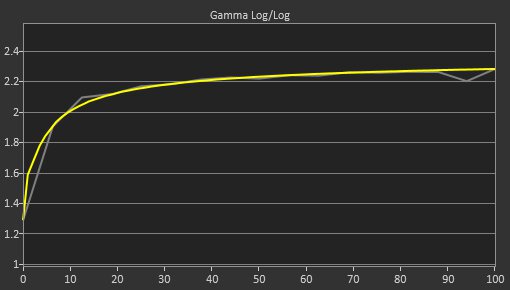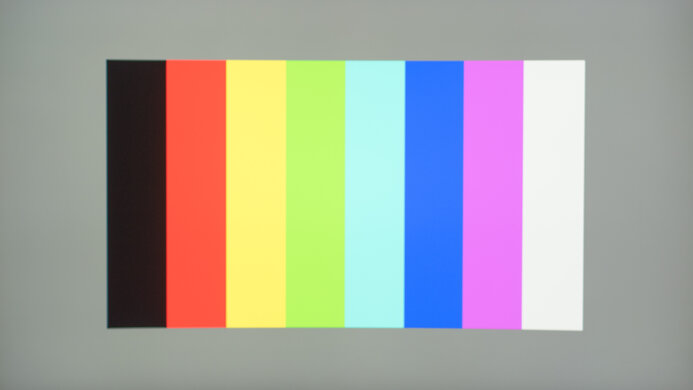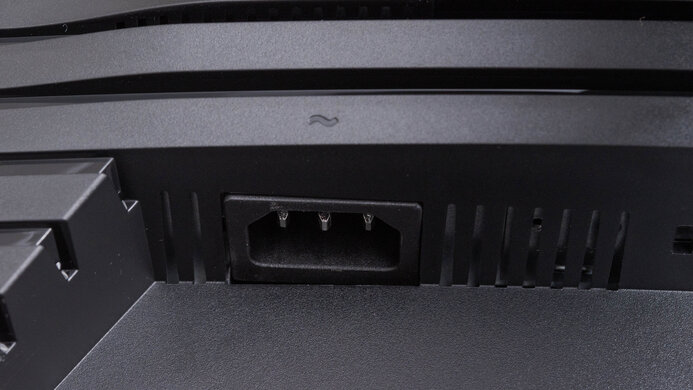The Dell S2721HGF is a great budget gaming monitor with a curved screen. It delivers smooth and responsive gameplay thanks to its low input lag, excellent response time, and 144Hz refresh rate. It has an optional Black Frame Insertion feature that can improve motion clarity, and it supports variable refresh rate technology to reduce screen tearing. It has a high contrast ratio to produce deep blacks, making it a good option for dark rooms, and it provides good visibility in bright settings. Although it has a VA panel, the viewing angles are okay, good enough for sharing content casually or playing co-op games. However, images still look slightly inaccurate from the side and might not be ideal for sharing work that requires accuracy. Lastly, it doesn't support HDR, and it only allows for height and tilt adjustments.
Our Verdict
The Dell S2721HGF is decent for most uses. It has low input lag, fast response time, and a high refresh rate, making it great for gaming. However, it's only decent for work and media consumption, mainly due to its 1080p resolution and poor ergonomics. Its viewing angles are okay, better than most VA panels. They're good enough for sharing content casually or co-op gaming, but not for sharing work that requires image accuracy. Unfortunately, it doesn't support HDR.
- High contrast ratio.
- Good reflection handling.
- Large screen size.
- Poor ergonomics.
- 1080p resolution might be too low for some.
- Images look slightly inaccurate from the side.
The Dell S2721HGF is decent for office use. It has a large screen that allows you to open multiple windows side-by-side; however, the 1080p resolution might be too low for some. The viewing angles are okay, good enough for sharing work such as Word documents or Excel spreadsheets, but there's still some loss of image accuracy when viewed from the side, so it might not be ideal if you need to share work that requires precision. Unfortunately, the ergonomics are sub-par as it only allows for height and tilt adjustments.
- High contrast ratio.
- Good reflection handling.
- Large screen size.
- Poor ergonomics.
- 1080p resolution might be too low for some.
- Images look slightly inaccurate from the side.
The Dell S2721HGF is great for gaming. It has excellent response time, low input lag, and a 144Hz refresh rate, resulting in smooth and responsive gameplay. It supports Adaptive Sync and is compatible with FreeSync and G-SYNC to reduce screen tearing. Its 1080p resolution isn't the most immersive, but it helps to achieve a higher frame rate, especially for those with lower-end hardware. It has a VA panel with a high contrast ratio, allowing it to produce deep blacks, great for gaming in the dark.
- High refresh rate.
- Excellent response time.
- High contrast ratio.
- Large screen size.
- Poor ergonomics.
- 1080p resolution might be too low for some.
The Dell S2721HGF is decent for media consumption. It has a large 27 inch screen that feels immersive, but the 1080p resolution might be too low for some. It handles reflections well and gets bright enough to fight glare in well-lit rooms, and it has a high contrast ratio that makes it great for dark rooms. The viewing angles are okay and should be good enough for sharing content casually, although there's still some loss of image accuracy when viewed from the side. Unfortunately, it doesn't support HDR.
- High contrast ratio.
- Good reflection handling.
- Large screen size.
- Poor ergonomics.
- 1080p resolution might be too low for some.
- No HDR support.
The Dell S2721HGF is decent for content creation. It has an excellent SDR color gamut with near-full sRGB coverage and good Adobe RGB coverage. The screen provides plenty of space for multitasking, but the 1080p might not be enough for some people. Sadly, while the viewing angles are okay and quite good for a VA panel, images still look slightly inaccurate when viewed from the side. Also, the ergonomics are poor, so it might be hard to place the screen at your optimal viewing position.
- High contrast ratio.
- Good reflection handling.
- Excellent SDR color gamut.
- Large screen size.
- Poor ergonomics.
- 1080p resolution might be too low for some.
- Images look slightly inaccurate from the side.
- No HDR support.
The Dell S2721HGF doesn't support HDR.
Check Price
Differences Between Sizes And Variants
We tested the Dell S2721HGF 27 inch gaming monitor, and it's the only size available. There are other similar monitors with various configurations, some of which you can see in the table below.
| Model | Size | Panel Type | Resolution | Refresh Rate | Curved |
|---|---|---|---|---|---|
| S2721HGF | 27" | VA | 1920 x 1080 | 165Hz | Yes |
| S2721DGF | 27" | IPS | 2560 x 1440 | 165Hz | No |
| S2421HGF | 24" | TN | 1920 x 1080 | 144Hz | No |
| S3220DGF | 32" | VA | 2560 x 1440 | 165Hz | Yes |
If someone comes across a different type of panel or their Dell S2721HGF doesn't correspond to our review, let us know and we'll update the review. Note that some tests, such as gray uniformity, may vary between individual units.
Our unit was manufactured in October 2020; you can see the label here.
Popular Monitor Comparisons
The Dell S2721HGF is a great budget gaming monitor. However, its 1080p resolution might be too low for some, especially for work or media consumption. The AOC CQ27G2 is a great 1440p option that performs similarly gaming-wise, but it doesn't get as bright to combat glare, and it has narrower viewing angles. For more options, check out our recommendations for the best budget gaming monitors, the best 1080p monitors, and the best 27 inch monitors.
Overall, the Dell S2721DGF performs better than the Dell S2721HGF. The S2721DGF has a 1440p resolution compared to the S2721HGF's 1080p and a higher 165Hz refresh rate. It also has a better response time at max refresh rate and 60Hz, resulting in clearer images in fast-moving scenes. The S2721DGF has an IPS panel with much wider viewing angles, and the stand allows for more ergonomic adjustments, making it a better choice for sharing content or playing co-op games. If you often game in the dark, the S2721HGF might be a better choice due to its higher contrast ratio.
The Dell S2721HGF and the Acer Nitro VG271 Pbmiipx are both 1080p 144Hz monitors and very similar in terms of gaming performance. The main difference is the panel type. The Dell has a VA panel that makes it a better choice for dark rooms, while the Acer has an IPS panel with wider viewing angles. The Acer is better for bright rooms due to its higher peak brightness, and it supports HDR. Also, it has a faster total response time at 60Hz with less overshoot, making it a better choice for 60fps console gaming.
The Dell S2721HGF and the AOC CQ27G2 score similarly overall; however, there are a few differences between them. The AOC has a higher 1440p resolution compared to the Dell's 1080p, making it a better choice if you also use it for work, but its response time isn't as good as the Dell's, especially in dark scenes. Both monitors have VA panels that are well-suited for dark rooms; however, the Dell is better for well-lit rooms because it gets a lot brighter. If you often share your screen with others, the Dell has wider viewing angles, but it doesn't allow for any swivel adjustment, which the AOC does.
The Dell S2721HGF is better overall than the Lenovo ThinkVision M14, mainly because they're for different uses. The Dell is a curved screen monitor designed with gamers in mind as it has a higher 144Hz refresh rate, VRR support, and much quicker response times. It's also a better choice for use in dark rooms because it has a much higher native contrast ratio. For well-lit rooms, the Dell gets brighter and has better reflection handling. On the other hand, the Lenovo is a portable monitor meant for on-the-go use. It has a smaller screen, resulting in a higher pixel density and better text clarity.

We buy and test more than 30 monitors each year, with units that we buy completely on our own, without any cherry-picked units or samples. We put a lot into each unbiased, straight-to-the-point review, and there's a whole process from purchasing to publishing, involving multiple teams and people. We do more than just use the monitor for a week; we use specialized and custom tools to measure various aspects with objective data-based results. We also consider multiple factors before making any recommendations, including the monitor's cost, its performance against the competition, and whether or not it's easy to find.
Test Results

The Dell S2721HGF has a somewhat gamer-oriented design that's almost identical to the Dell S2721DGF, but with a curved screen. It has thin borders on three sides with a slightly thicker bottom bezel and a simple stand with a hexagon-shaped base.
The stand is a mix of metal and plastic. It's very sturdy, and the monitor doesn't wobble much. The base is smaller than the one on the Dell S2721DGF, leaving you more usable desk space.
The back is plastic and looks almost identical to the Dell S2721DGF, but without the RGB lighting around the airflow vents. The cutout in the stand is for cable management.
The Dell S2721HGF doesn't have a local dimming feature. The video above is provided for reference only.
The Dell S2721HGF has good SDR peak brightness. There's virtually no variation in brightness when displaying different content. It's bright enough to provide good visibility in most lighting conditions, but it may struggle a bit to overcome intense glare in very bright, sunlit rooms.
We measured the SDR peak brightness after calibration in the 'Custom' Picture Mode with Brightness set to max.
This monitor doesn't support HDR.
The horizontal viewing angles are okay, better than most VA panel monitors. It should be good enough for sharing content casually or for co-op gaming, but it isn't ideal for sharing work that requires image accuracy. If you prefer something with better viewing angles, then look into the HP X24ih.
The vertical viewing angles are mediocre. This makes the image look inaccurate if you have the monitor mounted above eye level.
The Dell S2721HGF has excellent gray uniformity; however, this can vary between units due to manufacturing tolerances. Dirty screen effect is pretty minimal, but the left side of the screen is visibly darker than the rest. Uniformity is much better in near-dark scenes.
The Dell S2721HGF has great accuracy out of the box. Most colors and shades of gray are only slightly inaccurate and hard to spot. The color temperature is on the warm side, which gives the picture a slight reddish tint. Gamma follows the sRGB curve relatively well, but both dark and bright scenes appear darker than they should. Note that accuracy can vary between individual units.
Accuracy is exceptional after calibration. The remaining color inaccuracies aren't visible to the naked eye, and white balance is nearly perfect. The color temperature is much closer to our 6500K target, just a little on the cooler side. Gamma is much improved, but very dark and very bright scenes are now slightly too bright.
You can download our ICC profile calibration here. This is provided for reference only and shouldn't be used, as the calibration values vary per individual unit due to manufacturing tolerances, even for the same model.
The Dell S2721HGF has an excellent SDR color gamut. It has near-full coverage of the commonly-used sRGB color space and good coverage of the Adobe RGB color space, which is mostly used for photo editing. If you want something with much better coverage of the Adobe RGB color space, then consider the MSI Optix G27C6.
This monitor doesn't support HDR.
This monitor doesn't support HDR.
There are no signs of image retention, even after displaying a high-contrast image for ten minutes. However, this can vary between individual units.
Text clarity is decent. Windows ClearType can improve clarity a bit (top photo), especially with diagonal lines, but it behaves strangely as it causes some pixels to remain partially lit. We're not sure what causes this behavior. We tested it with different computers and obtained the same results.
| Overdrive Setting | Response Time Chart | Response Time Tables | Motion Blur Photo |
| Fast | Chart | Table | Photo |
| Super Fast | Chart | Table | Photo |
| Extreme | Chart | Table | Photo |
The Dell S2721HGF has excellent response time at its max refresh rate. It's a little slow in the darker transitions, so you may notice a bit more blur trail in dark scenes. The best overdrive setting is 'Super Fast' because it provides the best performance while keeping overshoot at an acceptable level.
| Overdrive Setting | Response Time Chart | Response Time Tables | Motion Blur Photo |
| Fast | Chart | Table | Photo |
| Super Fast | Chart | Table | Photo |
| Extreme | Chart | Table | Photo |
The response time at 60Hz is decent. However, it's much slower than at its max refresh rate, and there's also more overshoot. The best overdrive setting is again 'Super Fast', which means you don't have to change the overdrive setting if your frame rate drops. The 'Extreme' option has a slower total response time and significantly more overshoot. If you want a monitor with a better 60Hz response time, consider the Dell G2722HS.
The Dell S2721HGF has an optional Black Frame Insertion feature to improve motion clarity called MPRT, and it's accessible as an overdrive setting in the settings menu. However, it isn't usable while VRR is active, and it only works within a narrow frequency range. Note that the BFI score is based on the minimum and maximum frequency at which it can operate, not the BFI's performance.
The Dell S2721HGHF has a high refresh rate to deliver a smooth and responsive gaming experience, and it supports Adaptive Sync to reduce screen tearing. It's compatible with FreeSync and G-SYNC; however, G-SYNC only works over a DisplayPort connection.
The Dell S2721HGF has exceptionally low input lag, resulting in an extremely responsive gaming experience. Most people shouldn't feel any delay.
The Dell S2721HGF has a decent resolution and size. The 27 inch screen provides an immersive gaming experience and plenty of space for multitasking. However, the 1080p resolution might be too low for some, especially for productivity.
The Dell S2721HGF has a few additional features, including:
- Timer: Adds a timer on the screen.
- Frame rate counter: Adds an overlay showing the current frame rate.
- Display alignment: Helps align displays in a multi-monitor setup.
- Dark stabilizer: Makes objects more visible in dark scenes.
















































